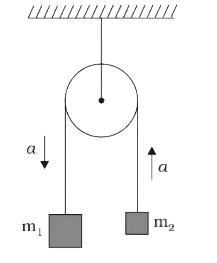Two bodies have the same heat capacity. If they are combined to form a single composite body, show that the equivalent specific heat of this composite body is independent of the masses of the individual bodies.
To solve the problem of finding the equivalent specific heat of a composite body formed by two bodies with the same heat capacity, we will follow these steps:
Step 1: Define the heat capacities of the two bodies
Let:
- Body 1 has mass m1 and specific heat s1.
- Body 2 has mass m2 and specific heat s2.
Since the heat capacities are equal, we have:
C1=C2⟹m1s1=m2s2(1)
Step 2: Write the expression for the heat capacity of the composite body
When the two bodies are combined, the total mass of the composite body is:
m′=m1+m2
The heat capacity of the composite body is given by:
C′=m′s′=m1s1+m2s2
Step 3: Substitute the heat capacity relationship into the equation
From equation (1), we know that m1s1=m2s2. Therefore, we can replace m2s2 in the equation for C′:
C′=m1s1+m2s2=m1s1+m1s1=2m1s1
Step 4: Express the specific heat of the composite body
Now, substituting this into the equation for the specific heat s′:
s′=C′m′=2m1s1m1+m2
Step 5: Substitute m2 in terms of m1 and s1,s2
Using equation (1) again, we can express m2 as:
m2=m1s1s2
Now substituting this into the expression for s′:
s′=2m1s1m1+m1s1s2=2m1s1m1(1+s1s2)
This simplifies to:
s′=2s11+s1s2=2s1s2s2+s1
Conclusion
Thus, we find that the equivalent specific heat s′ of the composite body is:
s′=2s1s2s1+s2
This shows that the specific heat of the composite body is independent of the masses m1 and m2 of the individual bodies.
Let:
- Body 1 has mass m1 and specific heat s1.
- Body 2 has mass m2 and specific heat s2.
C1=C2⟹m1s1=m2s2(1)
When the two bodies are combined, the total mass of the composite body is:
m′=m1+m2
The heat capacity of the composite body is given by:
C′=m′s′=m1s1+m2s2
From equation (1), we know that m1s1=m2s2. Therefore, we can replace m2s2 in the equation for C′:
C′=m1s1+m2s2=m1s1+m1s1=2m1s1
Now, substituting this into the equation for the specific heat s′:
s′=C′m′=2m1s1m1+m2
Using equation (1) again, we can express m2 as:
m2=m1s1s2
Now substituting this into the expression for s′:
s′=2m1s1m1+m1s1s2=2m1s1m1(1+s1s2)
This simplifies to:
s′=2s11+s1s2=2s1s2s2+s1
Thus, we find that the equivalent specific heat s′ of the composite body is:
s′=2s1s2s1+s2
This shows that the specific heat of the composite body is independent of the masses m1 and m2 of the individual bodies.
Topper's Solved these Questions
- BOOK - CENGAGE PHYSICS ENGLISHCHAPTER - CALORIMETRYEXERCISE - Exercise 1.123videos
CALORIMETRY
- BOOK - CENGAGE PHYSICS ENGLISHCHAPTER - CALORIMETRYEXERCISE - Exercise 1.222videos
CALORIMETRY
- BOOK - CENGAGE PHYSICS ENGLISHCHAPTER - BASIC MATHEMATICSEXERCISE - Exercise 2.620videos
BASIC MATHEMATICS
- BOOK - CENGAGE PHYSICS ENGLISHCHAPTER - CENTRE OF MASSEXERCISE - INTEGER_TYPE1videos
CENTRE OF MASS
Similar Questions
Two bodies of specific heats C1andC2 having same heat capacities are combined to form a single composite body. What is the specific heat of the composite body?
View SolutionTwo bodies of specific heats s1ands2 having same heat capacities are combinated to form a single composite body. Find the specific heat of the composite body.
View SolutionDefine specific heat of body.
View SolutionThe heat capacity of a body depends on
View SolutionThe specific heat capacity of a body depends on
View SolutionHow is the heat capacity of the body related to its specific heat capacity ?
View SolutionThe ratio of specific to molar heat capacity of a body
View SolutionTwo identical plates with thermal conductivities K and 3K are joined together to form a single plate of double thickness. The equivalent thermal conductivity of one composite plate so formed for the flow of heat through its thickness is.
View SolutionTwo bodies of masses m1andm2(<m1) are connected to the ends of a massless cord and allowed to move as shown in figure. The pulley is both massless and frictionless. The acceleration of the centre of mass is (m1−m2)n(m1+m2)2g. Find the value of n.
 View Solution
View SolutionPart of the body having a single pair of bones is
View Solution

